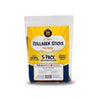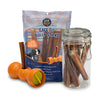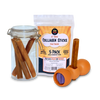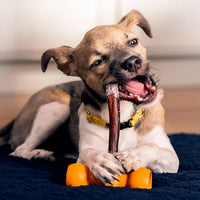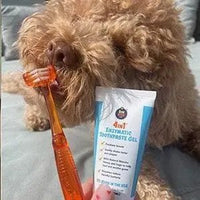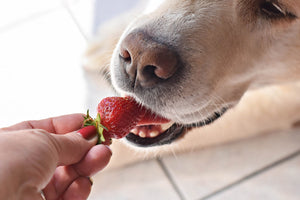It’s that time of year when the days are getting shorter and the temperatures are cooling down, and as a result, many of our dogs spend less time outdoors exercising. This sudden reduction in physical activity can often lead to unexpected weight gain that has long-lasting impact on your dog’s overall health, joints and energy levels.
But here’s the good news: with a few minor adjustments to your pup’s diet and exercise routine, you can help keep weight gain at bay.
Each dog is unique, with varying physical and caloric needs that are influenced by age, breed, metabolism and overall health. The recommendations below are a starting point to help you integrate changes that are suitable and customizable to your dog’s individual needs.

Why Cooler Days Affect Your Dog’s Energy Needs
When the temps drop and night falls earlier, it’s completely normal for dogs to become less active. Afternoon walks tend to be shorter and outdoor playtime less frequent. That means lounging inside where it’s cozy and warm becomes the new norm. But these subtle shifts in activity can have a real impact on your dog’s metabolism.
Just like humans, if your dog burns fewer calories but continues to consume the same amount of food and treats, those extra calories get stored as fat, and weight can creep up fast. This is especially true when we turn to food-based mental enrichment (like treat puzzles or food-stuffed toys) to keep our dogs occupied during the colder months. The calorie surplus adds up, and once it does, it can be tough to shed those extra pounds.
Not all dogs are the same, so stay mindful of the dog in front of you. Senior dogs often move less during colder months because mobility becomes harder. Short-haired and small dogs also tend to prefer indoors when the thermometer drops. Some breeds that thrive in cold weather, like Huskies, Malamutes and Great Pyrenees, may actually need more calories to stay warm and active. Recognizing that your dog’s energy needs change with the seasons allows you to be proactive to avoid weight gain rather than reacting to it once it’s already occurred.
Adjusting Caloric Intake
When your dog’s daily activity decreases, their caloric intake should decrease too. But before cutting back their food, which is formulated according to AAFCO guidelines to ensure minimal nutrient intake for their life stage, look first at their treat intake.
Can you reduce the number of treats each day or week and use your dog’s regular food for rewards instead? I’m not suggesting adding more food but rather taking a small portion of their meal and setting it aside for training or enrichment.
I’m also not recommending drastic caloric cuts. A reduction of about 5–10% is usually ideal when activity levels drop. Before adjusting anything, assess your dog’s body condition score (BCS). it’s an easy, hands-on, visual way to monitor changes without relying on a scale.
Tip: If you’re unwilling to limit treats (no judgment here!), you can reduce meal size slightly, but consider adding a multivitamin to ensure your dog still receives all essential nutrients.
Focus on Nutrient Quality
I’m a big believer that quality matters more than quantity, especially in the cooler months. Feeding high-quality proteins and moderate amounts of healthy fats helps maintain lean muscle and keeps your dog satisfied even with fewer calories.
- Protein: Supports metabolism and preserves muscle even when exercise is reduced.
- Healthy fats: Omega-3 fatty acids from fish oil or sardines support joint comfort, provide energy and maintain skin and coat health in dry winter air.
- Fiber and antioxidants: Seasonal veggies like carrots or green beans add bulk, aid digestion and supply micronutrients without extra calories.
Whatever you do, now is not the time to “fill your dog up” with high-carb, high-starch foods or treats as this will lead to accelerated weight gain.
Hydration Still Matters
Hydration is important year-round. Even though many dogs tend to drink less in colder weather, proper hydration is still essential for digestion, nutrient absorption and joint health.
If you notice your dog’s water bowl isn’t emptying as quickly, try these simple strategies:
- Add a splash of warm water or bone broth to meals (don’t let the food get mushy; just mix and serve).
- Offer wet or gently cooked food to increase moisture intake.
- Keep water at room temperature; it’s more inviting for most dogs.
Tip: These hydration tricks are beneficial year-round, not just in winter.

Treats and Snacks: Quality Over Quantity (Again)
More indoor time often means more puppy eyes and the temptation to hand out extra treats “just because.” I get it! But be mindful of how quickly those calories can add up.
Consider nutrient-dense or lower-calorie options such as:
- Dehydrated or freeze-dried single-ingredient meats or organs
- Crunchy veggies like cucumber slices, green beans or blueberries
- Low-calorie lickable treats like pet-safe bone broth frozen in a puzzle toy or lick mat
Small swaps like these keep your dog engaged and rewarded without overloading calories.

Monitoring Weight and Body Condition
Remember, a few extra pounds may not seem like much, but for a dog, even small gains can significantly strain joints, organs and metabolism. Think about it, two pounds on a 20-pound dog is a 10% weight increase. That’s like a 150-pound person gaining 15 pounds!
So, take a few minutes each week to check on your dog’s body condition. If you cannot feel ribs easily without pressing through fat, can’t see a visible waist from above or don’t see a slight tummy tuck from the side, it’s time to adjust portions or activity before weight gain continues.
Special Considerations
If your dog is older, has mobility issues or is managing a chronic condition, be extra mindful with dietary adjustments. Weight gain can worsen inflammation, joint pain and fatigue.
That said, some illnesses or healing processes require additional calories, not fewer. If in doubt, talk with your veterinarian or a qualified pet nutritionist before making major changes to your dog’s calorie intake.
Final Thoughts
Seasonal changes come every year, some more dramatically than others, depending on where you live, and they affect your dog’s needs just as they affect yours.
With a bit of proactive planning that includes small diet adjustments, you can help your dog stay lean, energized and healthy as ever through the cooler months. And now that you’re aware, it’s easy to make a few intentional tweaks that will set your dog up for wellness all year round.
Johnna Devereaux is a Clinical Pet Nutritionist, canine wellness expert and Chief Nutrition Officer for Bow Wow Labs.
* This article is for informational purposes only. It is not, nor is it intended to be, a substitute for professional medical or veterinary advice, diagnosis, or treatment and should never be relied upon or perceived as specific medical or veterinary advice.
**The points of view expressed above are those of our clinical nutritionist and are supported by science, her education and experience. We are committed to providing the best, most straightforward, and most helpful information possible to help keep your dog happy, healthy and safe.



